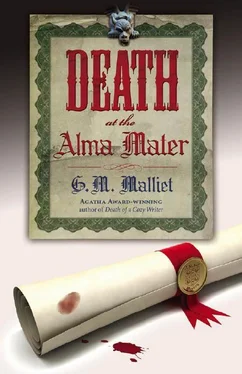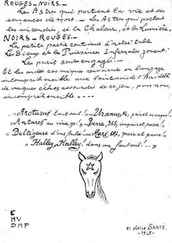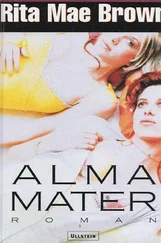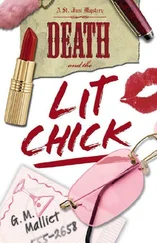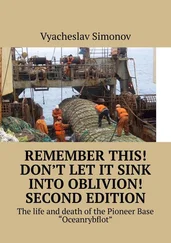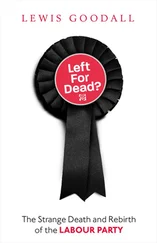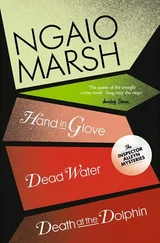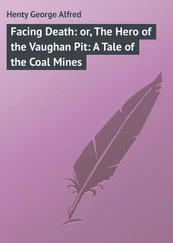G Malliet - Death at the Alma Mater
Здесь есть возможность читать онлайн «G Malliet - Death at the Alma Mater» весь текст электронной книги совершенно бесплатно (целиком полную версию без сокращений). В некоторых случаях можно слушать аудио, скачать через торрент в формате fb2 и присутствует краткое содержание. Жанр: Классический детектив, на английском языке. Описание произведения, (предисловие) а так же отзывы посетителей доступны на портале библиотеки ЛибКат.
- Название:Death at the Alma Mater
- Автор:
- Жанр:
- Год:неизвестен
- ISBN:нет данных
- Рейтинг книги:3 / 5. Голосов: 1
-
Избранное:Добавить в избранное
- Отзывы:
-
Ваша оценка:
- 60
- 1
- 2
- 3
- 4
- 5
Death at the Alma Mater: краткое содержание, описание и аннотация
Предлагаем к чтению аннотацию, описание, краткое содержание или предисловие (зависит от того, что написал сам автор книги «Death at the Alma Mater»). Если вы не нашли необходимую информацию о книге — напишите в комментариях, мы постараемся отыскать её.
Death at the Alma Mater — читать онлайн бесплатно полную книгу (весь текст) целиком
Ниже представлен текст книги, разбитый по страницам. Система сохранения места последней прочитанной страницы, позволяет с удобством читать онлайн бесплатно книгу «Death at the Alma Mater», без необходимости каждый раз заново искать на чём Вы остановились. Поставьте закладку, и сможете в любой момент перейти на страницу, на которой закончили чтение.
Интервал:
Закладка:
G M Malliet
Death at the Alma Mater
"In Xanadu did Kubla Khan A stately pleasure-dome decree, Where Alph, the sacred river, ran Through caverns measureless to man Down to a sunless sea." -Samuel Taylor Coleridge Webster was much possessed by death And saw the skull beneath the skin. -T. S. Eliot
ALMA MATER
Founded around the time King Henry VIII was selling off "his" monasteries, St. Michael's College of the University of Cambridge spreads in haphazard fashion by the River Cam, a model of functional medieval architecture wedded to Tudor bombast and, later, Victorian excess.
The University itself, of which the college is a part, was formed by a group of tearaway scholars escaping the wrath of the townspeople of Oxford, where clashes had ended with two students being hanged for murder, which incident should have given everyone in Cambridge pause. But by this time-the early 1200s-the inhabitants of Cambridge had survived the Romans, the Saxons, the Vikings, and the Normans, and, perhaps numbed into apathy at the sight of yet more new arrivals, rashly allowed the fledgling seat of learning to take hold.
St. Mike's, as it is inevitably called, is one of the lesser-known of thirty-two Cambridge colleges-a former Master liked to insist it was as well known as Trinity, which is like saying Marks and Spencer is as well known as Harrods-and it has never, even from its earliest days, been among the wealthiest of colleges. Indeed, it has more than once in its long history flirted with financial disaster. One early benefactor, having promised the college a substantial legacy, on the strength of which promise the college incurred various debts, was found on his death to be worth only?23. There were many other such incidents as the college slumbered its way through the centuries, betraying either a touching naivete or a rampant incompetence on the part of those entrusted with St. Mike's care.
The college was, however, given a boost in early Victorian times by an infusion of funds from the will of a wealthy owner of smoke-belching smokestacks in the Midlands. A painting of this scowling, mutton-chopped benefactor hangs, like an old- fashioned ad for castor oil, in pride of place in the Hall-one of the conditions of his bequest. But this benefactor's funds, too, had long since gone to repair the crumbling brick and clunch of the chapel, and by the late 1980s exuberant but doubtful investments in the stock market and offshore hedge funds had shrunk the college's coffers still further. The stone walls, chipped in places and worn to a gloss in others, continued to flake and wear like a favored old coffee mug, and the college remained a constant source of anxiety for the Bursar and others in whose care she was entrusted. (Although named for a male saint, St. Michael's is female, as are all the colleges, and a high-maintenance female, at that.)
So it was that as the twentieth century neared a close, the then-Master decreed "Something Must Be Done," and the answer came back from the Senior Combination Room, as it had done since time immemorial: "Let's hit up the old members for donations."
Something resembling energy infused the normally antebellum spirit of the SCR. Brochures were produced on one of the college's antique computers, and pleas personally signed by the Master were mailed out by the hundreds. This campaign met with little success (a thunderous silence, in fact), so much so that the suggestion of one wag-that the fundraising brochure be illustrated by a photo of a starving student holding a tin cup-was taken under serious consideration for as long as two weeks. Finally another idea was broached: Why not tempt graduates back to the college during the summer for a St. Mike's Open Weekend? The initial thought was that college members of specific years of matriculation would be invited, but over time it became the custom to carefully screen the guest list to include only the most successful-in monetary terms, that is-graduates. (One weekend in 1991 creative artists spawned by St. Mike's were invited, an experiment that was never to be repeated, as the artists proved not only to be living in less-than-genteel poverty, but to have accepted the invitation in the hope of being offered stipended Fellowships. They ended up alleviating their disappointment by making chip shots on the college's manicured lawns and dressing the statue of the College's Founder in women's undergarments. One specialist in "Found Art" left behind in his room a large tortoise. The hysterical bedder who discovered it was instrumental in instituting the ban on artists' weekends at St. Mike's. A specialist in tortoise biology easily being located-this was Cambridge, after all-the tortoise was duly adopted and lived to a ripe age somewhere in the region of North Piddle.)
The Bursar was generally assigned the task of combing through the lists of members who, for good or ill, had made their mark on the world, and had been well compensated for the marking up. He gradually began to notice that 1988 had been a bonanza year for such luminaries at the college-that over the course of the past twenty or so years, several of the members who had matriculated or were in some way attached to the college in that year had achieved success and, more to the Bursar's purposes, accumulated great wealth. It seems 1988 was one of those times, not unlike the Renaissance, perhaps, when the world burst with new ideas and energy before subsiding once more into its habitual indolence. In any event, the Bursar soon had a short list of worthies-the Master had asked that the gatherings be kept to under ten members, since spouses and guests were also encouraged to attend-and the college Fellows were duly summoned to hear the announcement concerning the upcoming festivities, to which most of them would not be invited.
("Good Lord, the idea is to get the old members to donate, not to revive any horrid lingering memories they may be harboring of the place," the Master had been heard to say. "No, the Fellows must be told in no uncertain terms: They are to stay away from the visitors unless instructed otherwise.")
Over the years, a regular program had evolved to keep the targeted visitors suitably entertained. They would be invited to partake of a dinner on a Friday and a special buffet lunch in the Master's Lodge on a Saturday, with a tea that afternoon and a Choral Evensong followed by a formal dinner in Hall, watched over by the portraits of the colleges' Masters down through the years (portraits which had gotten bigger and bigger in an unspoken competition for Most Beloved and Important, so that the march of centuries, if not progress, was easy to trace). On Sunday would be a Sung Eucharist in the Chapel. As a special treat, the Library and College Gardens would be flung open, with lectures offered by the College Archivist and the Head Gardener, and an exhibition of College Silver would be mounted in the Senior Combination Room. An added highlight-a veritable piece de resistance-was a tour of select student rooms, all carefully purged beforehand of traces of graffiti, scraps of unwashed clothing, seminal Marxist tracts, and empty liquor bottles.
In short, it always promised to be a weekend of the most stupendous dullness for any but the most steadfast and loyal alumnus or alumna, but in fact it proved over the years a surprisingly popular and successful venture, especially among the Americans, especially once a tasting of the College wines was added to the program. The Secretary of the College Wine Committee, an attractive man with a gift for smooth repartee, was on hand to answer questions on these occasions, where cases of College port and sherry were offered for sale, with free shipping thrown in for the Americans.
If all went according to plan, purse strings (and tongues) would be loosened, and the coffers of St. Mike's would once more fill to overflowing.
Читать дальшеИнтервал:
Закладка:
Похожие книги на «Death at the Alma Mater»
Представляем Вашему вниманию похожие книги на «Death at the Alma Mater» списком для выбора. Мы отобрали схожую по названию и смыслу литературу в надежде предоставить читателям больше вариантов отыскать новые, интересные, ещё непрочитанные произведения.
Обсуждение, отзывы о книге «Death at the Alma Mater» и просто собственные мнения читателей. Оставьте ваши комментарии, напишите, что Вы думаете о произведении, его смысле или главных героях. Укажите что конкретно понравилось, а что нет, и почему Вы так считаете.
